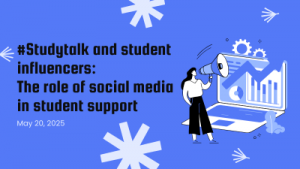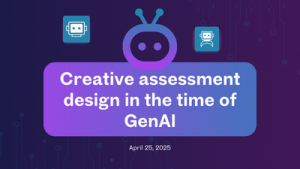Zhou Huiling and Juuso Henrik Nieminen
When a student learning to play the guitar asks his teacher, “How am I doing?” he is seeking feedback on his playing skills. In higher education, feedback seeking refers to students’ proactive behavior of soliciting information regarding their performance from the learning environment (De Stobbeleir et al., 2011). For example, students can seek opinions, suggestions, or evaluations about their written assignments from teachers or peers. Students undergo formative and summative assessments, and feedback is intricately tied to assessment. As a result, formative feedback and summative feedback come into play (Hattie & Timperley, 2007). Students may elicit information in formal and informal approaches, such as written feedback on theses, emails, or lunchtime chats. This blog article will touch on how students seek performance-related information within formative and summative feedback.
Feedback seeking is proposed to be a student-centered process to enable learners to shift from passive roles in receiving feedback to proactive roles in producing feedback insights (Anseel et al., 2015). Importantly, while students can decide on their behaviors when seeking feedback, they may find themselves lacking the necessary skills or motivation to engage in independent learning, leading them to rely on their teachers. Moreover, the driving force of feedback seeking can originate from the inherent tendency for personal growth or external goals and pressures, such as aiming for higher scores or creating a positive impression on the feedback provider. In the latter case, students are fundamentally playing a passive role.
Studies usually employ two types of feedback-seeking strategies: inquiry and monitoring (Ashford & Cummings, 1983; Leenknecht & Carless, 2023). Inquiry usually occurs in explicit communication to elicit information, encompassing direct and indirect forms (Bing-You et al., 2018). Direct inquiry involves students formulating feedback questions and initiating conversations, whereas indirect inquiry involves not explicitly stating intentions. Monitoring typically takes place by observing others’ behaviors or the environment to gather relevant information. Students may explicitly compare to criteria, exemplars, and others’ performance or subconsciously experience, inquire, or inspire through reflection (Yan & Brown, 2017). The motivation behind students’ strategy choices could determine whether they fundamentally take on an active or passive role.
The ongoing research for my doctoral thesis focuses on feedback seeking, and some insights were gained from the preliminary data in the context of Chinese higher education.
Participants indicated that when encountering difficulties in their learning, they would initially attempt personal reflections or information searches, which is considered a natural process of independent learning. More recently, with the emergence of generative AI, students may also initiate a conversation with these models, such as ChatGPT. If they are able to make satisfactory improvements, they experience a sense of increased confidence. However, if they still require external suggestions or assistance, students tend to inquire of their teachers due to their expertise and the trusted relationship they have hopefully established. They typically initiate brief conversations with their teachers during class discussions or take a few minutes before or after classes. Alternatively, students prefer social networking software, like WeChat, rather than formal conversation channels like face-to-face office consultation. While students value the effectiveness of seeking feedback from teachers, they frequently turn to their peers for consultation as well. They usually seek out peers with whom they are acquainted or those who have achieved high-level performance in relevant subjects. Their conversations may occur in both formal and informal settings, such as classrooms, libraries, dormitories, or online. During these interactions, they engage in the exchange of thoughts or conduct online research.
Interestingly, it is found that feedback-seeking instances primarily focus on formative feedback during the learning process and prior to assessments, but participants rarely discuss summative feedback following assessments. This pattern may be attributed to students utilizing formative feedback as a means of enhancing their performance in summative assessment. Moreover, participants have predominantly employed inquiry-based methods in their seeking endeavors while seldom mentioning the monitoring approach, probably because it often operates in a natural and subconscious manner (Ashford et al., 2003).
One area that could be further developed is to explore the consequence and enhancement strategies regarding the limited recognition of the monitoring approach. For example, researchers aiming to understand and measure feedback-seeking tendencies would face the challenge of collecting sufficient data about students’ monitoring behavior. Intervention or training targeting student feedback literacy may potentially improve this aspect and maximize student learning potential.
—
当一个正在学习吉他的学生向老师问道:“我弹得怎么样?”时,他正在寻求关于自己吉他演奏技能的反馈。在高等教育中,寻求反馈是指学生积极主动地从学习环境中寻求关于自己学习表现的信息(De Stobbeleir et al., 2011)。比如,学生可以向老师或同学寻求关于自己的写作作业的看法、建议或评价。学生通常会经历形成性评估和总结性评估,而反馈与评估密不可分。 因此也就出现了形成性反馈和总结性反馈(Hattie&Timperley,2007)。学生可能会以正式和非正式的方式寻求反馈信息,比如针对论文寻求书面反馈、通过电子邮件寻求反馈,或在午餐时间进行交谈。本文将讨论学生是如何寻求形成性反馈和总结性反馈的。
寻求反馈是一个以学生为中心的学习过程,旨在使学生从消极接收反馈的角色转变为主动产生反馈洞察力的角色(Anseel et al., 2015)。值得一提的是,虽然学生在寻求反馈时可以选择不同的方式,但他们可能会发现自己缺乏必要的能力或动力,无法进行独立学习,从而只能依赖于老师的帮助。此外,寻求反馈的动力可能来自于学生追求个人成长的内在倾向,也可能来自于外在的目标和压力,比如想考取更高的分数,或者为了给反馈提供者留下好印象。在后一种情况下,学生实际上在扮演被动角色。
已有的研究通常谈及两种类型的反馈寻求方式:询问和观察(Ashford & Cummings,1983;Leenknecht&Carless,2023)。询问即通过直接沟通来寻求信息,包括直接询问和间接询问(Bing-You et al., 2018)。直接询问是指学生主动提出反馈问题,并展开一段对话;而在间接询问时,学生则不明确表达自己的意图。观察是指通过留意他人的行为或周围环境来收集相关信息。学生可以直接与(评分)标准、范例或他人的表现进行比较,也可以通过反思的方式在潜意识中感受、自问自答,或获得灵感(Yan&Brown,2017)。学生选择寻求反馈方式的动机从根本上决定了他们承担主动还是被动角色。
我正在进行的博士论文主要研究寻求反馈,已在中国高校内初步收集了一部分数据并进行了分析,由此获得一些新的见解。
参与者表示,当他们在学习中遇到困难时,会首先进行个人反思或信息搜索,他们认为这是独立学习的自然过程。近期随着生成式人工智能的出现,学生还会通过与这些模型进行对话(比如ChatGPT)来寻求反馈。如果这个过程能取得比较满意的提升,他们的自信心就会得以增强。然而,如果学生仍然需要他人的建议或帮助,就会选择询问老师,因为老师具备专业知识,学生对老师很信赖。他们可能会在课堂讨论过程中,或者在课前课后的几分钟内与老师进行简短的交谈。此外,学生也倾向于使用社交软件(如微信)而不是比较正式的对话渠道(如在办公室面对面咨询)。尽管学生认可老师提供的权威信息,但他们也经常向同学寻求反馈。他们一般会选择比较熟悉的同学或在相关学科中表现突出的同学进行交流。这些对话既可能发生在正式场合也可能发生在非正式场合,如教室、图书馆、宿舍或线上平台。在这些互动中,他们会进行观点的交流或进行线上搜索。
有趣的是,研究发现,学生寻求反馈的行为主要集中在形成性反馈上,通常发生在学习过程中和考试前,而很少讨论考试后的总结性反馈。这可能是因为学生认为形成性反馈可以提高他们在总结性评估中的表现。此外,参与者在寻求反馈时主要采用了询问的方式,很少提及观察,可能是因为观察通常发生在自然或者潜意识的状态下(Ashford et al., 2003)。
对观察方法有限的认知可能会产生一些后果,并且需要相应的策略进行改善,这方面仍待进一步探索。比如,当研究人员想要了解和衡量反馈寻求的倾向时,他们可能难以收集充分的数据来描述学生的观察行为。对此,通过干预或培训来提升学生的反馈素养,有可能改善这一问题,并最大程度地发挥学生的学习潜力。
Reference
Anseel, F., Beatty, A. S., Shen, W., Lievens, F., & Sackett, P. R. (2015). How Are We Doing After 30 Years? A Meta-Analytic Review of the Antecedents and Outcomes of Feedback-Seeking Behavior. Journal of Management, 41(1), 318–348.
Ashford, S. J., Blatt, R., & VandeWalle, D. (2003). Reflections on the looking glass: A review of research on feedback-seeking behavior organizations. Journal of Management, 29(6), 773–799.
Ashford, S. J., & Cummings, L. L. (1983). Feedback as an Individual Resource: Personal Strategies of Creating Information. In ORGANIZATIONAL BEHAVIOR AND HUMAN PERFORMANCE (Vol. 32).
Bing-You, R., Hayes, V., Palka, T., Ford, M., & Trowbridge, R. (2018). The art (and artifice) of seeking feedback: Clerkship students’ approaches to asking for feedback. Academic Medicine, 93(8), 1218–1226.
De Stobbeleir, K. E., Ashford, S. J., & Buyens, D. (2011). Self-regulation of creativity at work: The role of feedback-seeking behavior in creative performance. Academy of management journal, 54(4), 811-831.
Hattie, J., & Timperley, H. (2007). The power of feedback. In Review of Educational Research (Vol. 77, Issue 1, pp. 81–112). SAGE Publications Inc.
Leenknecht, M. J. M., & Carless, D. (2023). Students’ feedback seeking behaviour in undegraduate education: A scoping review. Educational Research Review, 40, 100549.
Yan, Z., & Brown, G. T. L. (2017). A cyclical self-assessment process: towards a model of how students engage in self-assessment. Assessment and Evaluation in Higher Education, 42(8), 1247–1262.



